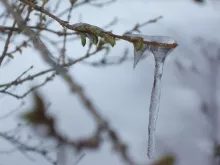Spring temperature backlashes
Seasonal changes and spring sensititvity
Tree species naturally occurring in central and northern Europe have the ability to acclimatize to seasonal changes in temperature, and can therefore tolerate very low temperatures during winter. However when trees start to deharden during spring, their sensitivity to sudden temperature backlashes increases.
Effects on forest stands
Even one or a few spring backlashes can be enough to cause a lasting negative effect on a forest stand, especially if the frost event occurs during the juvenile phase. A warmer climate will influence the fine balance between an increased risk for frost damage caused by earlier onset of vegetation processes and a decreased risk caused by generally warmer temperatures. To get a better picture of the risk of damage when the climate is changing, we develop models on tree phenology and frost hardiness.
Contact information
Department of Physical Geography and Ecosystem Science
Email: anna_maria [dot] jonsson [at] nateko [dot] lu [dot] se (anna_maria[dot]jonsson[at]nateko[dot]lu[dot]se)


